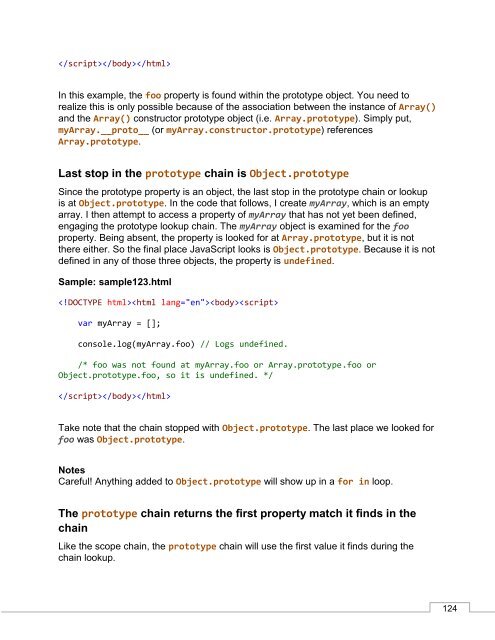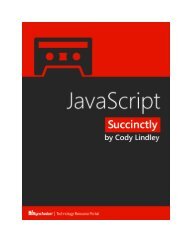JavaScript_Succinctly
Create successful ePaper yourself
Turn your PDF publications into a flip-book with our unique Google optimized e-Paper software.
In this example, the foo property is found within the prototype object. You need to<br />
realize this is only possible because of the association between the instance of Array()<br />
and the Array() constructor prototype object (i.e. Array.prototype). Simply put,<br />
myArray.__proto__ (or myArray.constructor.prototype) references<br />
Array.prototype.<br />
Last stop in the prototype chain is Object.prototype<br />
Since the prototype property is an object, the last stop in the prototype chain or lookup<br />
is at Object.prototype. In the code that follows, I create myArray, which is an empty<br />
array. I then attempt to access a property of myArray that has not yet been defined,<br />
engaging the prototype lookup chain. The myArray object is examined for the foo<br />
property. Being absent, the property is looked for at Array.prototype, but it is not<br />
there either. So the final place <strong>JavaScript</strong> looks is Object.prototype. Because it is not<br />
defined in any of those three objects, the property is undefined.<br />
Sample: sample123.html<br />
<br />
var myArray = [];<br />
console.log(myArray.foo) // Logs undefined.<br />
/* foo was not found at myArray.foo or Array.prototype.foo or<br />
Object.prototype.foo, so it is undefined. */<br />
<br />
Take note that the chain stopped with Object.prototype. The last place we looked for<br />
foo was Object.prototype.<br />
Notes<br />
Careful! Anything added to Object.prototype will show up in a for in loop.<br />
The prototype chain returns the first property match it finds in the<br />
chain<br />
Like the scope chain, the prototype chain will use the first value it finds during the<br />
chain lookup.<br />
124



